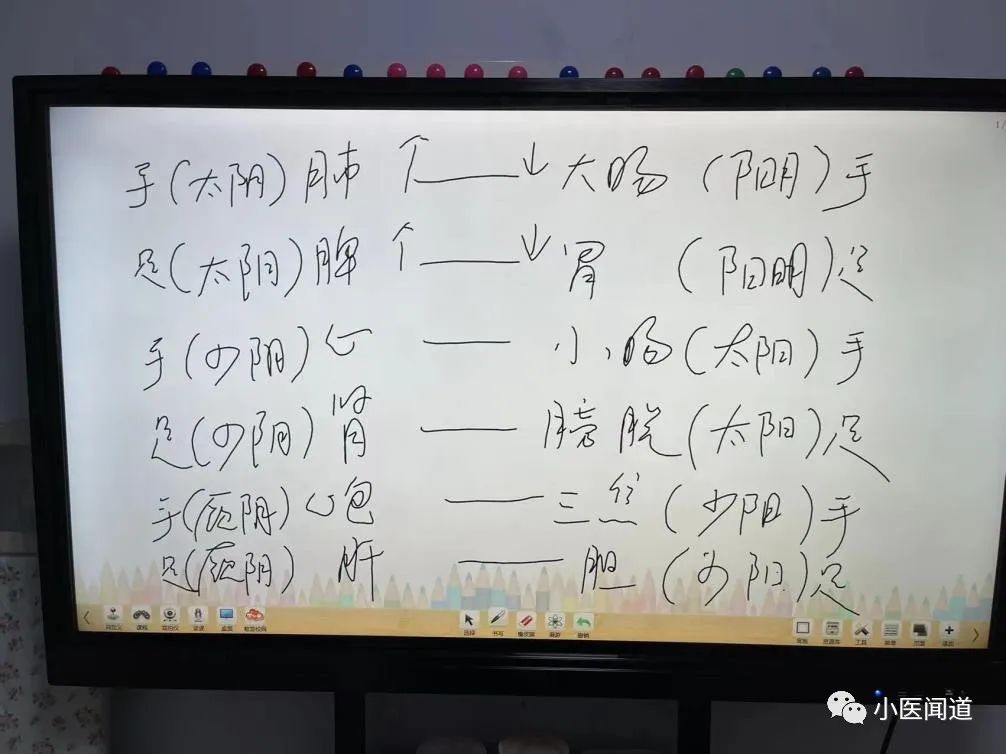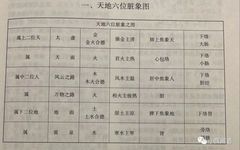2022-04-13 Medical Origins: Lesson Six – The Relationship Between Zang-Fu Organs and Their Connections
Students, today we will discuss the final part of the diagram of the six positions of heaven and earth, which is the relationship between the Zang-Fu organs and their connections.。
1. The Relationship Between the Five Zang Organs and the Six Fu Organs
1. The Relationship of Exterior and Interior
Many people who have studied Traditional Chinese Medicine (TCM) know that the lungs are connected to the large intestine, the heart to the small intestine, the spleen to the stomach, the kidneys to the bladder, and the liver to the gallbladder. However, few people, at least as far as I know, study what kind of relationship exists between them and why this connection exists. In fact, we can find clues through the diagram of the six positions of heaven and earth.。

2. The Connection Relationships
Looking at the last part of this diagram, we note several terms: the lungs are the lower connection to the large intestine, the pericardium connects to the small intestine, the liver connects to the gallbladder, and the kidneys are adjacent to the bladder. The spleen connects to the stomach. We should pay attention to these terms, as they relate to anatomical structures and their positions.。
Yesterday, we specifically discussed the liver and gallbladder, noting that they are interconnected. We can consider that the liver and gallbladder are linked. Therefore, it is important to note that the liver does not connect to the gallbladder; rather, the liver connects to the gallbladder meridian. The liver meridian and gallbladder meridian are close in position, but their pathways are interconnected.
The spleen ascends while the stomach descends; the spleen is above, and the stomach is below. The kidneys and bladder are also connected. In TCM, the area between the two kidneys is referred to as the Mingmen (Gate of Life), with the bladder located below and adjacent to the kidneys. The kidneys control the opening and closing of the bladder, which is also divided into left and right.
3. Characteristics of the Five Zang and Six Fu Organs
The five Zang organs are the liver, heart, spleen, lungs, and kidneys. The Zang organs are considered Yin, storing essence and Qi without discharging it. This means that their energy is stored and cannot be casually expended or discarded; they are energy reservoirs. During the metabolic process, they also produce waste and must expel excess energy. As the saying goes, “Excess Qi becomes fire.” How do we expel this excess? We need an outlet, which is where the six Fu organs come in. The Fu organs discharge but do not store; they are channels. Therefore, each of the five Zang organs corresponds to a Fu organ, creating a balance. This means that the relationship between the exterior and interior organs is a balance, which we refer to as a small balance of regions.。
2. The Upper Two Positions of Heaven
1. Lungs and Large Intestine
For example, the lungs are responsible for breathing in the pure Qi of heaven and earth, symbolizing the sky and representing the purest Qi. Their function is to disseminate and descend. The dissemination refers to the inhalation of pure Qi, while the second function is to disseminate the grains sent from the spleen and stomach. After we digest and absorb the food we eat, the lungs transport it throughout the body. During this process, some waste is produced. As mentioned earlier, “Excess Qi becomes fire.” In cases of pneumonia, fever, or bronchitis, especially in children, you may notice that when a child with a cold and fever has a bowel movement, they seem to recover. In cases of pneumonia and fever, the excess Qi leads to a feeling of fullness and distension. At this time, the excess Qi cannot be expelled through the mouth. We have a formula called Sanzi Yangqin Tang (Three Seed Nourishing Drink), which many people may remember: Suzi (Perilla Seed), Baijiezi (White Mustard Seed), and Laifuzi (Radish Seed). Why do we use Laifuzi? It is because this seed, especially Laifuzi, breaks Qi and resolves accumulation. It can help expel gas, right? Everyone knows that eating radish can help with gas. The effect of radish seeds is even more pronounced, so when the Qi moves downward, the lungs feel less distended. We will discuss this further when we cover the relevant organs. You should know that the lightest substance, the lungs, is the purest of all, located at the top of the blue sky, while its counterpart is the most turbid substance, which is expelled as feces through the large intestine. Thus, the pure and turbid are separated here.
2. Heart and Small Intestine
The heart, which is connected to the small intestine, is one of the hottest areas in our body. I once asked a classmate who used to slaughter pigs, and he said that the heart and small intestine are so hot that they cannot be touched after the pig is slaughtered. I have never slaughtered a pig, so I cannot verify this, but he said it is true. The heart fire and small intestine fire are both very intense. Clinically, a common condition of excessive heart fire manifests as canker sores, which are referred to as heart fire. How do we resolve heart fire?
(1) Bamboo Leaves:
One commonly used herb is bamboo leaves, which clear heart fire and promote urination. The small intestine has the function of separating the clear from the turbid. When you are anxious and have excess heat, your urine will be yellow and strong-smelling, indicating heart fire.
(2) Green Tea and Dao Chi San
If you do not have bamboo leaves, what can you do to clear heart fire? In my hometown, we have another method: drink green tea with white sugar or rock sugar, but do not use brown sugar, as it is warming and will increase internal heat. It must be green tea. After drinking it, it promotes urination. In TCM, there is a formula called Dao Chi San, which consists of Mu Tong (Akebia), Che Qian Zi (Plantago Seed), along with Gan Cao (Licorice) and bamboo leaves. This formula clears heart fire and directs it to the small intestine, allowing it to be expelled through urination.
(3) Deng Xin Cao (Lampwick Grass)
Another herb is Deng Xin Cao, which can also be boiled in water to clear heart fire. We will discuss this further later.
We must understand that the two upper organs—the heart and lungs—are located in the upper jiao, and their counterparts are the lower connections, which lead downwards to the lower jiao, where they expel waste. One is the large intestine, and the other is the small intestine, with one leading to the posterior yin and the other to the anterior yin. This is what we call the connection between the upper and lower.
Now, let’s look at the lower connections: the lungs connect to the large intestine, and the heart connects to the small intestine. This is the heavenly part.
3. The Middle Two Positions of Humanity
1. Liver and Gallbladder
In the middle, the liver and gallbladder are interconnected. They are located in the same area, but their meridian pathways are very close. In the legs, one is on the outer side and the other on the inner side, resonating with each other. Therefore, below, the liver meridian and gallbladder meridian are connected through the connecting vessels.
2. Spleen and Stomach
The spleen and stomach have always been one entity. The Taiyin and Yangming are also one entity, responsible for digestion and absorption. The spleen Qi transports the nutrients absorbed from digestion upwards to the lungs, while the stomach receives food from the mouth for initial digestion before it enters the small intestine. We have discussed this process extensively before, so we will not elaborate further here. Remember that the spleen and stomach are adjacent, just as the liver and gallbladder are.
The kidneys and bladder are also adjacent.
Thus, the relationship between the organs in the middle jiao and lower jiao is that they are all neighbors. Since they are neighbors, what connects them? It is the meridians. Therefore, each meridian must be connected through the connecting vessels, starting from their origin, forming a small cycle.
The lungs and large intestine are connected; the lungs and large intestine connect at the index finger. In the Zang-Fu organs, the lungs originate from the middle jiao and follow the stomach, while the large intestine meridian starts from the index finger and connects to the lungs, passing through the diaphragm. Thus, one pathway starts from the middle jiao, which can be understood as the stomach and intestines, while the other descends from the lungs, forming a cycle.
The heart and small intestine are similarly connected, and the meridians of the Zang-Fu organs are interconnected in this way.
4. The Sequence of the Twelve Meridians

This is a sequence chart of the twelve meridians, which also shows how they connect with each other. You can see many patterns through this chart. For example::
1. Yin and Yang: The left side includes the lungs, spleen, heart, kidneys, pericardium, and liver, all of which belong to Yin; while the large intestine, stomach, small intestine, bladder, san jiao, and gallbladder belong to Yang. The five Zang organs are Yin, and the six Fu organs are Yang.
2. Meridians: “Accumulating Yin is Earth, accumulating Yang is Heaven.”
Let’s look at all the meridians, which contain three parts. For example, the lung meridian is called the Hand Taiyin Lung Meridian, and the Hand Yangming Large Intestine Meridian. In our future applications, this contains three different meanings:
(1) For example, the lungs are one of the five Zang organs, while the large intestine is one of the six Fu organs.
(2) Taiyin or Yangming refers to their positions; Taiyin is external, while Hand Taiyin is the upper limb, and its pathway runs along the inner side of the arm. Yangming is on the outer side of the arm, which is the side exposed to sunlight, while Taiyin is the side that does not receive sunlight. This is related to the transportation of the six Qi of heaven and earth, which is also related to the five movements and six Qi, as well as the seasonal changes throughout the year and the patterns of pathogenic Qi in the body.
(3) The hand and foot refer to their pathways. Problems that arise along these pathways indicate issues with the corresponding meridian, which in turn affects the associated Zang-Fu organs. Each Zang-Fu organ has its inherent symptoms.
In the coming time, our studies will be categorized based on the symptoms of these meridians and Zang-Fu organs. We will identify which symptoms correspond to which Zang organ, which Fu organ, whether they are excess or deficiency, and we will list the corresponding formulas and herbs. This way, even if you cannot remember everything, you can follow the chart to find the relevant symptoms. For example, if you have a cough, you can identify it as a lung issue and determine which herbs to use and how to prescribe them.

Finally, if you can understand the diagram above, then you have comprehended these six lessons.
The public sharing concludes here. Until we meet again.

